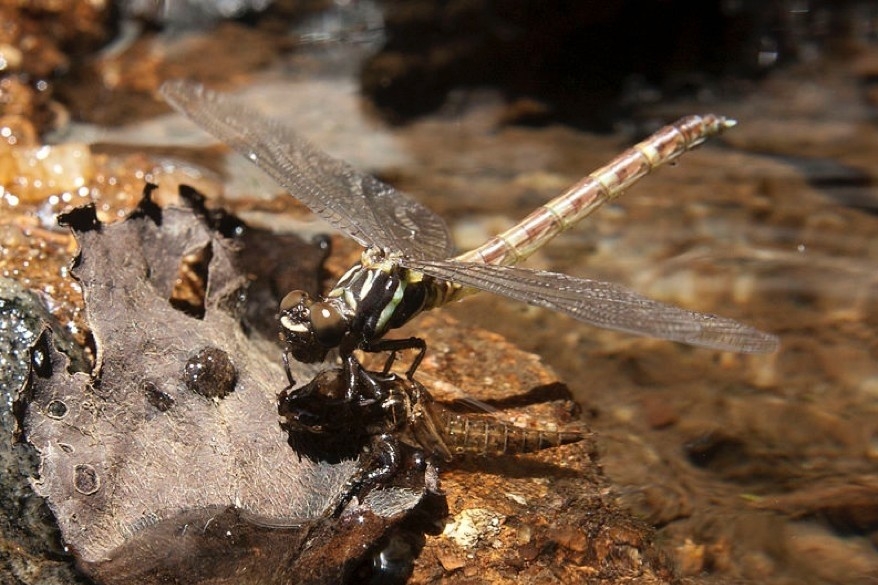


Analysis of data collected over 20 years suggests the decline is due to the construction of over 180 dams on the Paraná and its tributaries (dragonfly emerging from aquatic naiad state; photo: Alexandre Castagna/Wikimedia Commons)
Published on 08/30/2021
By José Tadeu Arantes | Agência FAPESP – Research conducted in Brazil for more than 20 years in the Paraná River basin shows a drastic fall in the number of aquatic insects in the region, which is considered well-preserved and distant from the negative impacts of agriculture, cattle breeding, and urbanization.
The fieldwork was done by researchers affiliated with the State University of Maringá’s Center for Research in Limnology, Ichthyology and Aquaculture (NUPELIA-UEM). The data was systematized by Gustavo Romero, a professor at the University of Campinas’s Institute of Biology (IB-UNICAMP). An article on the study is published in a special issue on insect decline of Biology Letters, a journal of the UK’s Royal Society.
“Our study analyzed data collected on a seasonal basis over a 20-year period. We detected a decline from thousands to tens of individuals per square meter,” Romero told Agência FAPESP.
A commentary on the study by one member of the team is published in The Conversation.
The drastic decline in insect populations is a global phenomenon, Romero said, and studies have shown its correlation with human activities. A meta-analysis published in Science pointed to a fall in the number of terrestrial insects but claimed to have detected a rise in the abundance of aquatic insects. This article has since been contested by critics who argue that its authors based their conclusions on too small a sample, with only 7% of the insect datasets in their analysis coming from the tropics and the rest almost exclusively from the United States and Europe.
Romero et al. studied a floodplain with an area of 40 square kilometers containing rivers, shallow lakes, channels and backwaters. The main cause of the decline in insect populations there was the construction of over 180 dams along the Paraná and its tributaries, which form one of South America’s largest freshwater systems, draining much of the central and southern portion of the continent.
The study was supported by FAPESP via two grants awarded to Romero (18/12225-0 and 19/08474-8), and a postdoctoral fellowship awarded to Pablo Antiqueira, also a co-author of the published article. The study was conducted under the aegis of the FAPESP Research Program on Biodiversity Characterization, Conservation, Restoration and Sustainable Use (BIOTA-FAPESP) and the FAPESP Research Program on Global Climate Change (RPGCC).
“A sharp decline was observed not only in more susceptible species but in all aquatic insect orders and families that live in the area. These insects inhabit freshwater environments until they reach adulthood when they migrate to terrestrial environments. This includes dragonflies and water beetles, to mention only the most well-known,” Romero said.
Because some insects transmit diseases (e.g. Aedes aegypti, which transmits dengue, zika and yellow fever), many people wrongly think all insects are harmful to humans. “The insects that are being decimated in the Paraná River basin are extremely useful. They provide many ecosystem services, including pollination, biological control of crop pests and disease-transmitting insects, decomposition of organic matter, and nutrient cycling,” Romero said.
Consequence of dams
Dams have impacts of three kinds, Romero continued. First, they make the water much clearer because particles in suspension settle on the reservoir bed before the flow enters the spillway. Deprived of their murky water camouflage, the insects that live downstream of the dam are even more vulnerable to being eaten by fish.
Second, the exotic fish species introduced into dam reservoirs to promote sport fishing, such as the peacock bass (tucunaré) brought from the Amazon, are omnivores and eat insects as well as native fish.
The third type of impact detected was a chemical imbalance of the nutrients in the water, changing the proportions of nitrogen and phosphorus. “The algae that proliferate in dam reservoirs fix nitrogen from the atmosphere and transfer it to the water. Part of the phosphorus is deposited on the reservoir bed. The water that flows through the dam spillway is poor in phosphorus and proportionally richer in nitrogen as a result. This changes its nutritional quality, affecting the animals that depend on a balanced quantity of these nutrients,” Romero explained.
The Paraná River basin touches seven Brazilian states. Technically it is a sub-basin and, alongside the Paraguay and Uruguay River sub-basins, part of the Plata River system, one of South America’s three main basins. The other two are the Amazon and São Francisco River basins. Changes occurring in the ecosystems of the Paraná River sub-basin are therefore highly significant for the continent as a whole, and the decline in aquatic insect populations shows how human activities affect it even without taking into account the use of pesticides and sewage disposal into its rivers and lakes.
The world has some 5.5 million insect species, 80% of which have yet to be described by science. This huge animal population, the most numerous on the planet, is rapidly being reduced by human activities, characterizing what some researchers are already calling the “insect apocalypse”.
The article “Pervasive decline of subtropical aquatic insects over 20 years driven by water transparency, non-native fish and stoichiometric imbalance” can be retrieved from: royalsocietypublishing.org/doi/10.1098/rsbl.2021.0137.
Source: https://agencia.fapesp.br/36727